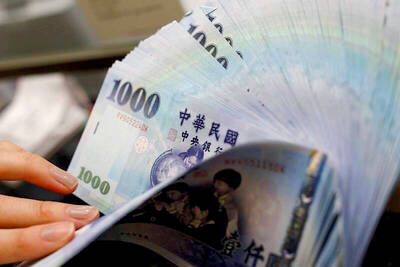The nation’s unemployment rate dropped to a two-year low of 4.92 percent last month from 5.05 percent in September after increasing private investment spurred business hirings, the Directorate-General of Budget, Accounting and Statistics (DGBAS) said yesterday.
Seasonally adjusted, the jobless rate declined for the 14th straight month to 4.96 percent last month from 5.08 percent in the previous month, DGBAS said, adding that payrolls rose 0.27 percent to 10.56 million last month from September.
“With the economy posting a robust recovery, private investment has increased and the government’s employment incentive programs continued to remain in place,” DGBAS Deputy Director Liu Tian-syh (劉天賜) told a media briefing.
The agency last week raised its GDP growth forecast to 9.98 percent for the full year after the economy expanded faster than expected in the third quarter and strong demand for exports promoted local companies to hire more workers.
Remaining optimistic about the local job market, Chen Miao (陳淼), director of the macroeconomic forecasting center at the Taiwan Institute of Economic Research (台經院), said by telephone that the robust economy was reflected in a decrease in layoffs because of fewer business closures.
“The number of employees in the industrial and service sectors also posted growth, which means companies have become more confident about the economy,” Chen said, adding that the next few months are the peak season for the service industry.
Until September, the unemployment rate had remained above 5 percent for the longest time in history, 22 months, according to the statistics bureau’s data.
Liu predicted that the unemployment rate would remain above 5 percent for the full year, as the rate averaged 5.31 percent in the first 10 months, saying that the rate would be higher than the 5.17 percent recorded in 2002 when the dot-com bubble burst.
“The unemployment rate would have reached 5.34 percent had it not been for the government’s employment incentive programs,” Liu said. “The number of jobs in public service created by the programs reached 1.05 million last month, up 93,000 from October 2008.”
The number of long-term unemployed dropped for the eighth month in a row to nearly 94,000 last month, down 4,000 from September, while the number of middle-aged people without work remained flat at 115,000, DGBAS data showed.
Looking ahead, the DGBAS predicted that the unemployment rate would continue to trend down until the Lunar New Year, despite worries that the expiration of short-term employment programs may drive the rate back up.
“Some [short-term employment programs] will continue and some will expire, but the robust growth will absorb the unemployed who had been covered by the programs,” Liu said, adding that it would not weigh on the unemployment rate.
Chen agreed, saying that manpower demand among enterprises remains robust, while playing down the impact of uncertainty over global economic growth on the local unemployment rate.

Merida Industry Co (美利達) has seen signs of recovery in the US and European markets this year, as customers are gradually depleting their inventories, the bicycle maker told shareholders yesterday. Given robust growth in new orders at its Taiwanese factory, coupled with its subsidiaries’ improving performance, Merida said it remains confident about the bicycle market’s prospects and expects steady growth in its core business this year. CAUTION ON CHINA However, the company must handle the Chinese market with great caution, as sales of road bikes there have declined significantly, affecting its revenue and profitability, Merida said in a statement, adding that it would

i Gasoline and diesel prices at fuel stations are this week to rise NT$0.1 per liter, as tensions in the Middle East pushed crude oil prices higher last week, CPC Corp, Taiwan (台灣中油) and Formosa Petrochemical Corp (台塑石化) said yesterday. International crude oil prices last week rose for the third consecutive week due to an escalating conflict between Israel and Iran, as the market is concerned that the situation in the Middle East might affect crude oil supply, CPC and Formosa said in separate statements. Front-month Brent crude oil futures — the international oil benchmark — rose 3.75 percent to settle at US$77.01

RISING: Strong exports, and life insurance companies’ efforts to manage currency risks indicates the NT dollar would eventually pass the 29 level, an expert said The New Taiwan dollar yesterday rallied to its strongest in three years amid inflows to the nation’s stock market and broad-based weakness in the US dollar. Exporter sales of the US currency and a repatriation of funds from local asset managers also played a role, said two traders, who asked not to be identified as they were not authorized to speak publicly. State-owned banks were seen buying the greenback yesterday, but only at a moderate scale, the traders said. The local currency gained 0.77 percent, outperforming almost all of its Asian peers, to close at NT$29.165 per US dollar in Taipei trading yesterday. The

RECORD LOW: Global firms’ increased inventories, tariff disputes not yet impacting Taiwan and new graduates not yet entering the market contributed to the decrease Taiwan’s unemployment rate last month dropped to 3.3 percent, the lowest for the month in 25 years, as strong exports and resilient domestic demand boosted hiring across various sectors, the Directorate-General of Budget, Accounting and Statistics (DGBAS) said yesterday. After seasonal adjustments, the jobless rate eased to 3.34 percent, the best performance in 24 years, suggesting a stable labor market, although a mild increase is expected with the graduation season from this month through August, the statistics agency said. “Potential shocks from tariff disputes between the US and China have yet to affect Taiwan’s job market,” Census Department Deputy Director Tan Wen-ling